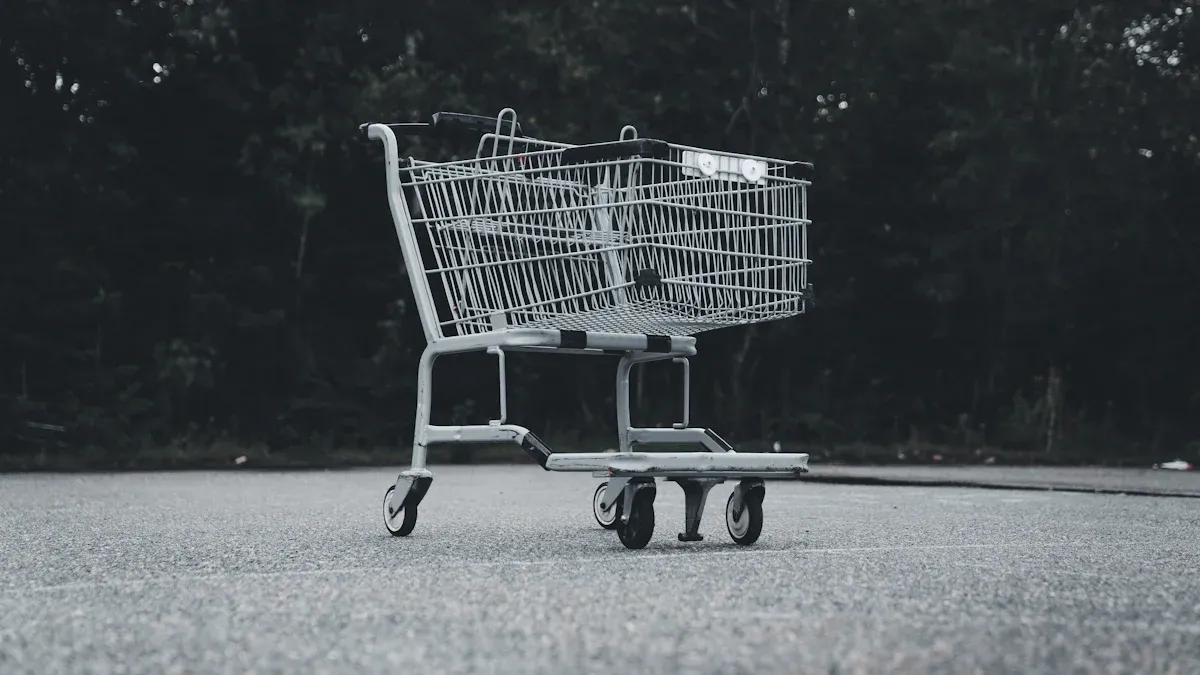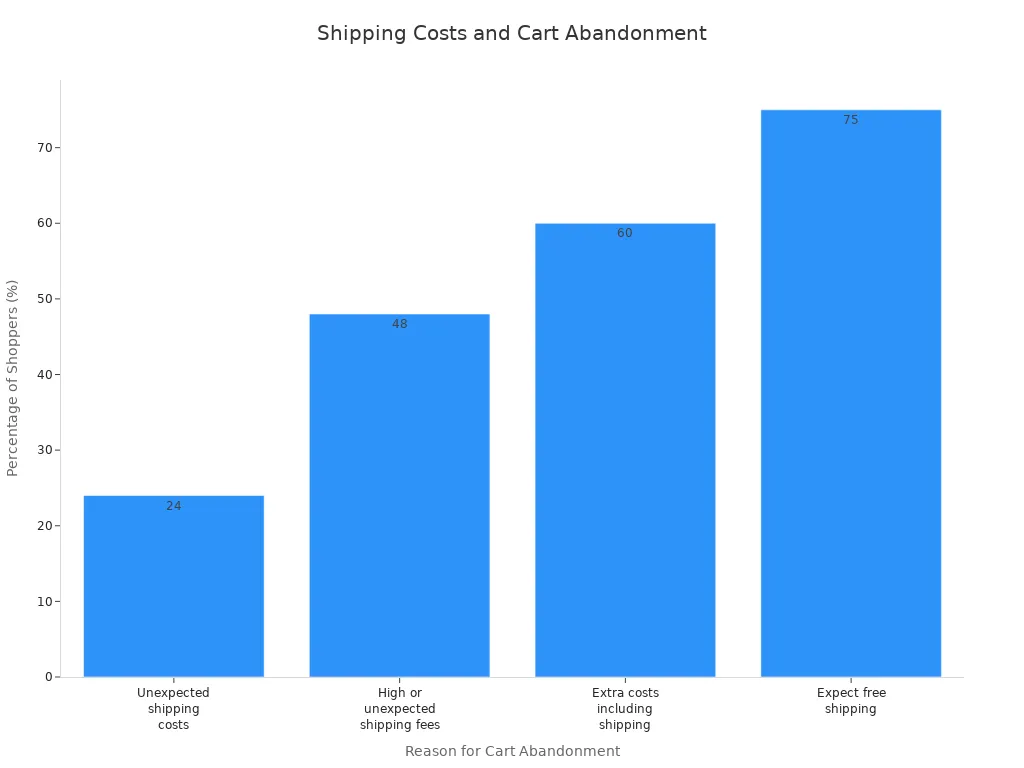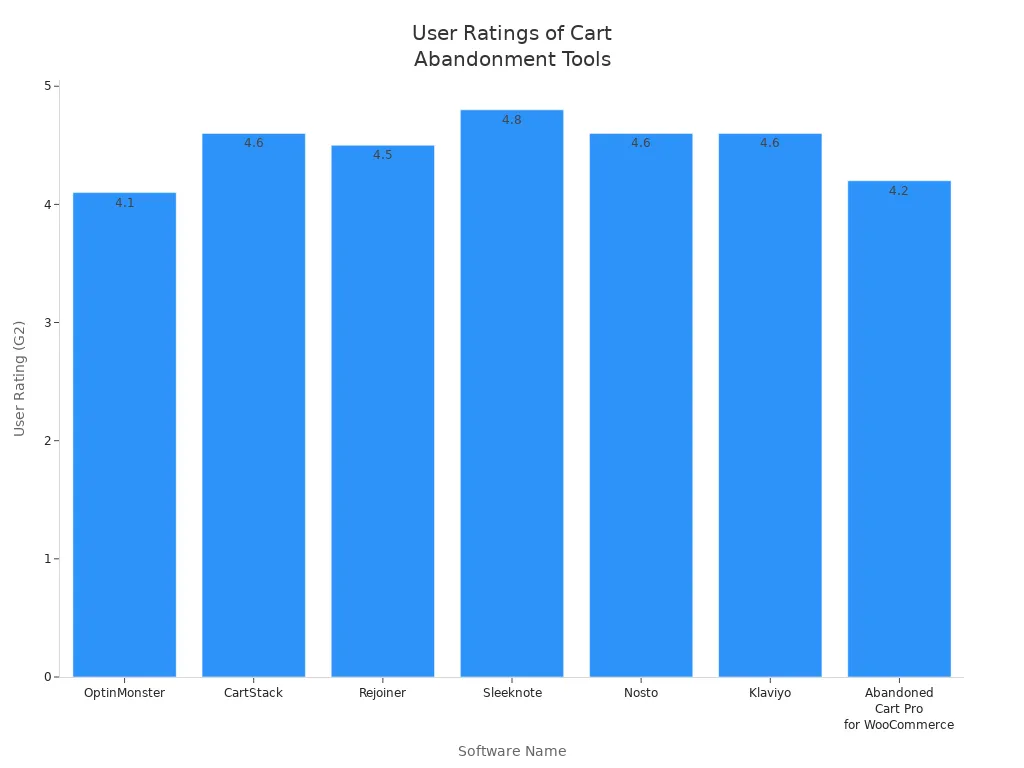Strategies to Reduce Abandonment in Shopping Carts and Increase Sales

Shopping cart abandonment hurts your business more than you might think. Every time a customer leaves without buying, you lose sales and growth.
Did you know the global average shopping cart abandonment rate in ecommerce sits at a staggering 75.45%? That means most shoppers leave before finishing their purchase.
You miss out on billions each year.
Retailers lose between $111 billion and $136 billion in revenue because of abandoned carts.
Many shoppers never return, while others buy from your competitors.
You can reduce abandonment with practical changes that make a real difference.
Key Takeaways
Show all costs upfront and keep checkout simple to avoid surprises and frustration that cause shoppers to leave.
Offer guest checkout and multiple payment and shipping options to make buying easy and flexible for all customers.
Use trust badges, clear return policies, and fast, mobile-friendly sites to build shopper confidence and reduce doubts.
Provide live chat support and personalized messages to help customers instantly and encourage them to complete purchases.
Send timely abandoned cart emails and use exit popups or retargeting ads to remind shoppers and recover lost sales.
Cart Abandonment Overview

What It Means
Shopping cart abandonment happens when you add products to your online cart but leave the website before finishing your purchase. This means you show interest in buying, but you do not complete the transaction. Every item you leave behind in your cart counts as abandoned.
Researchers often separate cart abandonment from checkout abandonment. Cart abandonment takes place when you leave items in your cart before you even start the checkout process. Checkout abandonment happens when you begin the checkout but exit before paying. Both types signal that something stopped you from buying, but cart abandonment usually happens earlier in your shopping journey.
The abandonment rate measures how many shoppers start a purchase but do not finish. For most ecommerce sites, this number is high—about 69% of carts get abandoned. This metric matters because it shows how many people want to buy but face obstacles that stop them.
When you abandon your cart, you send a clear message: something about the shopping experience did not work for you.
Why It Matters
You might think leaving a cart behind is no big deal, but it has a huge impact on online stores. High cart abandonment rates mean lost sales and wasted marketing dollars. Every time you leave a cart, the store loses a chance to make money and grow.
Many things cause you to abandon your cart:
Complicated or long checkout steps
Website errors or slow loading pages
Hidden costs like shipping or taxes
Forced account creation
Security worries
Limited shipping choices
Poor return policies
Lack of customer support
Just browsing or comparing prices
These problems create friction in your shopping journey. They make you hesitate or give up. When you leave, the store not only loses your sale but also risks damaging its reputation. If you do not trust the site or find it hard to use, you may never come back. That is why reducing cart abandonment is so important for every online business.
Main Causes
Unexpected Costs
You want to know the total price before you buy. Hidden fees, surprise shipping charges, or unexpected taxes make you feel tricked. When you see extra costs at checkout, you often leave your cart behind. You trust stores that show all costs upfront. Clear pricing builds confidence and keeps you moving toward purchase.
Complicated Checkout
A long or confusing checkout process makes you frustrated. You do not want to fill out endless forms or click through too many pages. Every extra step gives you a reason to quit. A simple, fast checkout helps you finish your order. Stores that streamline this process see more completed sales.
Account Creation
You value your time and privacy. When a store forces you to create an account, you may walk away. Research from the Baymard Institute, as cited by Shopify, shows that 26% of online shoppers abandon their carts when required to register. You want the option to check out as a guest. Stores that offer this choice keep more customers.
Payment and Shipping Issues
You expect flexible payment options and reliable shipping. If your favorite payment method is missing, you hesitate. Limited shipping choices or unclear delivery times make you doubt your decision. You want to know when your order will arrive and how you can pay. Stores that provide clear, flexible options win your trust.
Security Concerns
You care about your personal and financial information. Many shoppers leave carts behind because they do not trust the website.
Customers often abandon shopping carts due to lack of trust in third-party platforms.
Security worries, payment issues, and privacy concerns are key factors driving abandonment.
Negative or outdated social proof, such as old Facebook pages or unanswered negative Google reviews, worsens trust problems.
Expert AJ Saunders highlights that these trust issues significantly increase cart abandonment rates.
A notable 17% of consumers do not trust industries with their personal or credit card information. This fear of being left without support after purchase makes you think twice before buying.
Poor Mobile Experience
You shop on your phone for speed and convenience. A slow or clunky mobile site drives you away.
A poorly optimized mobile checkout process frustrates customers, leading to high shopping cart abandonment.
Research indicates that mobile abandonment rates for U.S. shoppers can reach approximately 85%, highlighting the severity of the issue.
The poor mobile experience is identified as a major reason under the broader category of complicated checkout processes, emphasizing the importance of mobile optimization to reduce abandonment.
You expect a smooth, easy mobile experience. Stores that deliver this keep you coming back.
Reduce Abandonment Strategies
Checkout Optimization
You want a fast and easy checkout. When you see too many steps or forms, you feel frustrated and leave. You can reduce abandonment by making checkout simple and smooth. Research shows that improving checkout design can boost conversions by over 35%. Try to keep your checkout to 12-14 form fields instead of the average 23. Offer guest checkout so you do not force shoppers to create an account. This one change alone can help you reduce abandonment and win more sales.
Evidence Aspect | Supporting Details |
|---|---|
Impact on Conversion Rates | Guest checkout reduces friction by allowing purchases without account creation, increasing conversions. |
Cart Abandonment | Mandatory account creation causes 26% of shoppers to abandon their carts. |
Shopper Preferences | Nearly 75% of online shoppers prefer to manually enter payment info via guest checkout. |
Customer Satisfaction | About 50% choose guest checkout for ease and convenience; 36% perceive it as less risky for fraud. |
Recommendations for Implementation | Use user-friendly, mobile-optimized checkout with visible security reassurances and clear navigation. |
You should also show a progress bar so shoppers know how many steps remain. Make navigation clear and let people edit their cart easily. Display all costs upfront, including shipping and taxes, to avoid surprises. Save cart contents automatically so shoppers can return later and finish their purchase. These steps help reduce abandonment and build trust.
Tip: Remove distractions like pop-ups during checkout. Keep the design clean and focused on finishing the sale.
Personalization
You want to feel understood when you shop. Personalization uses first-party data to show you products and offers that match your interests. When you see items you like or get reminders about your cart, you feel more likely to buy. AI tools can spot patterns in your shopping and send you personalized emails or offers if you leave your cart behind. This approach helps reduce abandonment by making you feel valued.
You can also use personalized exit-intent pop-ups. These appear when you try to leave the site and offer a discount or free shipping. This small nudge can convince you to finish your order. Personalized recovery emails work well, too. They remind you of what you left behind and sometimes include a special offer just for you.
Live Chat Support
You sometimes have questions or problems during checkout. Live chat support gives you instant help. When you can chat with a real person, you feel more confident and less likely to leave. Visitors who use live chat convert 5 to 10 times more than those who do not. A 24/7 live chat can increase conversions by up to 30%. If you get stuck on the payment page, live chat can solve your issue right away.
Proactive chat invitations during checkout reduce abandonment.
Live chat in abandoned cart emails lets you get answers fast.
Having live chat at night and on weekends captures more sales.
You can reduce abandonment by making sure help is always available. Even recovering 10% of abandoned carts through live chat can mean thousands of dollars in extra revenue each year.
Rewards Programs
You love getting rewards for shopping. A good rewards program gives you points, discounts, or special perks for completing your purchase. When you know you will earn something extra, you feel more motivated to finish your order. Rewards programs also encourage you to come back and shop again.
You can use rewards to reduce abandonment by offering bonus points for completing checkout or returning to finish a cart. Show these rewards clearly during the checkout process. Remind shoppers about their points or upcoming rewards in cart recovery emails. This extra value can tip the balance and help you decide to buy.
Note: Empathize with your shoppers. Understand their pain points and offer solutions that make their experience better. When you focus on their needs, you reduce abandonment and increase loyalty.
Build Trust and Transparency
Security Signals
You want to feel safe when you shop online. Security signals like trust badges and SSL certificates show you that a website protects your information. When you see these badges, you know your payment details stay private. Trust badges can boost conversion rates by up to 42%. Almost three out of four shoppers worry about credit card theft on new sites. If you do not see trust logos, you may leave without buying. The Norton SSL badge gives the highest sense of security for over a third of shoppers. Place these badges near your checkout button to calm last-minute worries. Even simple badges work better than none at all. Familiar payment logos like PayPal, Visa, and Mastercard also make you feel more confident.
Security Signal | Impact on Shoppers |
|---|---|
Trust Badges | Increase conversions by up to 42% |
Missing Trust Logos | 61% will not buy if badges are missing |
Norton SSL Badge | 35.4% feel highest trust |
Payment Logos | Reduce payment concerns for 9% of shoppers |
“Trust badges are like little signals on your website that scream, ‘Hey, it’s safe to shop here!’” – Rhea Diamante
Clear Policies
You want to know what happens if you need to return something. Clear return and refund policies help you feel secure. Stores like Zappos and Nordstrom offer easy, no-hassle returns. These policies make you more likely to finish your purchase. When you see a simple return policy, you trust the store more. Complicated or strict rules make you hesitate. You want to shop where you know you can get your money back if needed.
Easy return policies build trust and boost sales.
Clear rules reduce your worries about buying online.
Stores with simple returns keep you coming back.
Transparent Pricing
You hate surprise costs at checkout. Transparent pricing means you see all fees, including shipping, before you pay. Almost half of shoppers leave carts because of high or unexpected shipping fees. Three out of four expect free shipping, at least with a minimum order. Show shipping costs early, not just at the end. Offer choices like standard or express shipping. This honesty builds trust and helps you decide faster.

Tip: Show shipping fees on product pages or use a shipping calculator. This keeps you informed and happy to complete your order.
Transparent pricing and clear policies make you feel safe. When you trust a store, you are much more likely to buy.
User Experience

Site Speed
You want a website that loads fast. Slow pages make you feel impatient and frustrated. When a site takes too long, you often leave before buying. Technical glitches or errors during checkout can ruin your shopping experience. You deserve better.
Slow website speed and technical issues push shoppers away.
Session timeouts or errors during checkout cause you to abandon your cart.
Using a global CDN and optimizing images can make your site faster and more reliable.
Hazel Bolton, an optimization consultant, points out that even top-grossing sites lose big money because of poor site performance. You can avoid this loss by making your site quick and smooth. Fast websites keep you engaged and ready to buy.
Tip: Test your site speed often. Fix slow-loading pages right away to keep shoppers happy.
Mobile Optimization
You shop on your phone more than ever. Mobile traffic now makes up over half of all page views. If your mobile site is slow or hard to use, you will leave. A poor mobile experience can cause cart abandonment rates as high as 97%. You expect a site that works perfectly on your device.
Mobile users need a design made for phones, not just a copy of the desktop site.
Fast load times, easy navigation, and simple checkout steps keep you shopping.
Digital wallets like Apple Pay and Google Pay make checkout quick and easy.
Many shoppers start on mobile and finish on desktop, so your site must work well everywhere.
A mobile-first approach boosts your chances of making a sale. When you can shop easily on your phone, you are more likely to complete your purchase.
Easy Cart Editing
You want control over your cart. If you need to change something, you should do it quickly. Easy cart editing helps you move forward with your order instead of giving up.
Simple editing options encourage you to finish checking out.
Collapsible sections for shipping, payment, and order summary let you make changes fast.
Tagging updated information makes checkout clear and stress-free.
Etsy makes it easy to review and edit your cart, which helps more shoppers complete their orders. When you can fix mistakes or update details without hassle, you feel confident and ready to buy.
Remember: A smooth, user-friendly experience keeps you coming back and boosts sales for every store.
Flexible Options
Payment Methods
You want to pay your way. When you see your favorite payment method, you feel confident and ready to buy. Stores that offer many payment options make checkout easier for everyone. Tools like Primer help businesses show the right payment methods for each shopper, based on where you live and what you like. This keeps things simple and avoids confusion.
Research shows that 70% of shoppers say having their preferred payment method is a top reason for choosing a store. If you do not see your choice, you might leave your cart behind. Younger shoppers often use digital wallets, while older customers prefer credit cards. When you find the payment option you trust, you finish your purchase. Stores that offer more choices see fewer abandoned carts and happier customers.
Make checkout easy for yourself. Choose stores that let you pay the way you want.
Shipping Choices
You care about how and when your order arrives. Stores that give you shipping options help you shop with confidence. Some people want fast delivery, while others want to save money. You might even prefer picking up your package from a locker.
Multiple shipping choices fit your needs, whether you want speed or savings.
A good shipping experience builds trust and makes you want to shop again.
Clear delivery times and tracking keep you informed.
Flexible return policies make you feel safe.
Personal shipping options help you connect with the brand.
Almost 60% of shoppers say they are more likely to buy when they see a range of delivery options. Free shipping can boost sales by up to 30%. When you get the shipping choice you want, you are more likely to complete your order.
Delivery Estimates
You want to know exactly when your order will arrive. Seeing a clear delivery date before you buy helps you decide. Three out of four shoppers say that an estimated delivery date makes them more likely to finish their purchase. You trust stores that give you a real date, not just a vague window.
Exact delivery dates build trust and reduce worry.
Real-time delivery estimates help you plan.
Clear delivery info before checkout boosts your confidence.
If you see high delivery costs or long wait times, you might leave your cart. Stores that show fast, reliable, and clear delivery estimates win more sales. You deserve to shop with confidence, knowing when your order will arrive.
Recovery Tactics
Abandoned Cart Emails
You can win back lost sales with well-timed abandoned cart emails. These messages remind you about the items you left behind and encourage you to finish your purchase. Most stores see a recovery rate between 10% and 20% for these emails, which is a healthy average. If you optimize your emails, you can push that number even higher.
Recovery Rate Range | What It Means |
|---|---|
Under 10% | Needs improvement |
10% to 20% | Good, industry average |
20% to 30%+ | Excellent, well-optimized |
A strong abandoned cart email grabs your attention with a clear subject line, shows your abandoned items, and offers a simple way to return to checkout. These emails often get opened—about 41% open rate—and half of those who click end up buying. Send your first email within an hour to increase your chances.
Retargeting Ads
Retargeting ads follow you around the web and remind you of what you left behind. These ads use your browsing data to show you the exact products you almost bought. You see them on social media or other websites, making it hard to forget your cart.
Retargeting ads remind you if you got distracted.
They offer discounts or free shipping to help you decide.
They build trust by showing reviews and trust badges.
They create urgency with limited-time deals.
They personalize the message to match your interests.
Retargeting ads are one of the most powerful ways to reduce abandonment and recover lost sales.
Exit-Intent Popups
Exit-intent popups appear when you try to leave a site without buying. These popups can recover about 21% of abandoned carts and sometimes boost completed purchases by up to 50%. You might see a special offer, a discount, or a reminder about your cart. This last-minute nudge often convinces you to stay and finish your order.
Exit-intent popups can reduce abandonment rates by up to 35%.
They help you by offering deals or capturing your email for follow-up.
Tip: Use clear, simple offers in your popups to keep shoppers engaged.
Incentives
Personalized incentives give you a reason to come back and buy. You might get a discount, free shipping, or loyalty points based on your cart value or shopping history. Personalization makes you feel special and can increase sales by up to 20%. Multi-step recovery campaigns—using emails, SMS, popups, and ads—can boost recovery rates from 10-20% to 30% or more.
Start with a simple reminder.
Add urgency in follow-ups.
Offer discounts only if needed.
Use limited-time offers to create urgency.
When you combine these tactics, you reduce abandonment and turn lost carts into real sales.
Ongoing Optimization
Analytics
You need to track your shoppers’ actions if you want to reduce abandonment and boost sales. Google Analytics 4 (GA4) gives you powerful insights by following every step, from viewing a product to starting checkout and making a purchase. You can see exactly where customers leave and spot the biggest drop-off points. MonsterInsights makes this even easier for WordPress users. It connects with GA4 and shows you clear reports about your sales funnel and cart abandonment. With these tools, you can fix problems fast and keep more shoppers moving forward.
Software Name | Key Features | Pros | Cons | User Rating (G2) |
|---|---|---|---|---|
OptinMonster | Automated triggers, multistep lead capture forms | Personalized campaigns, widely used | Limited design options | 4.1/5 |
CartStack | Exit intent popups, email & SMS campaigns | Tailored automated emails | Challenging interface, limited templates | 4.6/5 |
Rejoiner | Personalized dynamic email campaigns | Good deliverability, real-time analytics | Complex segmentation, higher pricing | 4.5/5 |
Sleeknote | Popups, lead magnets, email campaigns | High customization | Limited reporting, lacks advanced targeting | 4.8/5 |
Nosto | AI-powered personalization, machine learning | Strong analytics, good support | Requires technical skills for full use | 4.6/5 |
Bunting | Personalization, cart abandonment emails | Prompt customer support | Dated interface | N/A |
Klaviyo | Email & SMS marketing, automation | Extensive automation, wide integrations | Steep learning curve | 4.6/5 |
Abandoned Cart Pro for WooCommerce | Email reminders, discount offers | Simple setup, customizable, automated emails | Limited to WordPress, slow support | 4.2/5 |

A/B Testing
You can make smart changes to your checkout process by running A/B tests. This means you show different versions of your site to shoppers and see which one works best. You might test a shorter checkout, a new button color, or a different offer. When you track results, you learn what helps shoppers finish their orders.
Test checkout steps to find the smoothest path.
Watch how shoppers react to new designs or offers.
Segment your audience by age, device, or traffic source for deeper insights.
Keep testing and improving, not just once but all the time.
A/B testing lets you make data-driven decisions. You keep your checkout fresh and customer-friendly. This ongoing process helps you reduce abandonment and grow your sales.
Customer Feedback
You should always listen to your customers. Ask them why they left their cart or what stopped them from buying. Use surveys, popups, or quick polls after checkout. When you gather feedback, you discover pain points you might miss in analytics.
Add a simple survey at the end of checkout.
Use popups to ask about the shopping experience.
Read reviews and respond to concerns.
When you act on feedback, you show shoppers you care. You build trust and loyalty. Your store becomes better every day, and more shoppers complete their purchases.
You have the power to reduce cart abandonment and boost your sales. Use a mix of strategies to improve trust, user experience, and recovery. Keep testing and watch your results grow. Start today—try one new tactic and track your progress.
Tip: Share your own tips or questions in the comments. Want to learn more? Check out our recommended resources for deeper insights!
FAQ
What is the best way to lower my cart abandonment rate?
You should simplify your checkout process. Remove extra steps. Offer guest checkout. Show all costs upfront. These changes make shoppers feel confident and ready to buy.
How soon should I send abandoned cart emails?
Send your first email within one hour. Quick reminders keep your brand fresh in the shopper’s mind. Fast follow-up increases your chances of winning back the sale.
Do trust badges really help increase sales?
Yes! Trust badges show your site is safe. Shoppers feel secure when they see them. You build trust and boost conversions by displaying these badges near your checkout button.
Why do mobile users abandon carts more often?
Mobile sites often load slowly or look messy. You need a mobile-friendly design. Fast loading and easy navigation keep shoppers engaged and help you close more sales.
See Also
Revolutionizing Online Store Management With AI E-Commerce Solutions
Analyzing Walgreens Self-Checkout Benefits And Retail Challenges
Understanding Cash Mistakes At Self-Checkout And How To Fix
Cloudpick Technology Delivering Seamless Cashierless Shopping Experience
